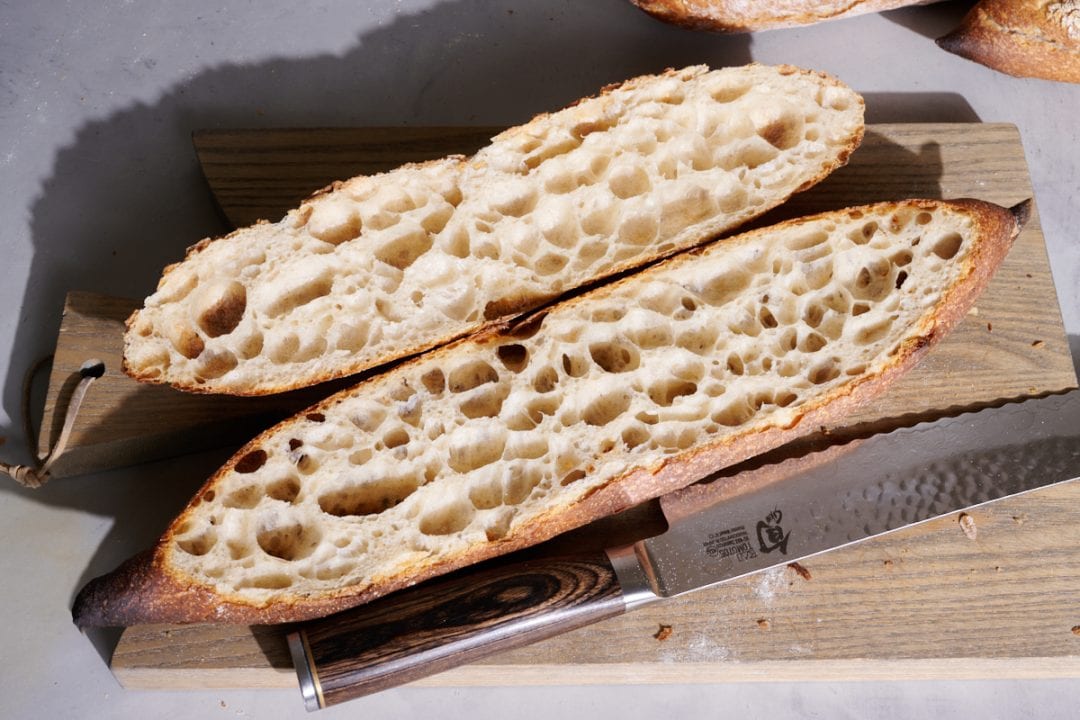You’ll often find me effusing about (one of) my favorite parts of a sourdough loaf: a thin and brittle crust. I have consistently strived for it since I started baking. For me, the textural contrast between a crisp crust’s snap and the tender, melt-in-your-mouth crumb is my hallmark for great sourdough bread.
Don’t get me wrong; there is a place for thick-crusted bread, too (I love Italian-style bread like you’ll find in Altamura that has a super crunchy crust). And when I say thin crust, I’m not talking about pale loaves that are underbaked to sidestep a thicker result. The Maillard reaction will always lend a well-baked crust a full bouquet of caramelization and malty notes. There are other levers to pull when planning your bake to ensure a thin and crisp, yet fully-baked, loaf.
Creating thin-crusted bread is not always easy, especially for a home baker who lacks a professional deck oven with steam injection at the press of a button. But fret not—it is possible to get a nicely brittle crust at home, and this guide is here to help.
Real Quick: Key Techniques for Getting a Thinner Crust
The following list of things can be done in isolation or combined to greater effect:
- More steam, for longer, at the beginning of baking
- Bake for less time at a slightly higher temperature
- Ensure dough is proofed sufficiently
- Bake dough without cold proofing (retardation)
We will look at each of these in detail, but first, let’s define exactly what we’re looking for with thin-crusted sourdough bread.

Baking and Crust Thickness Terminology
Just like when we taste bread, the following vocabulary will help us express what we’re looking for when we bake bread.
- Thick vs Thin Crust: For me, a thick crust is anything thicker than about ¼ inch.
- Crispy Crust: A crispy crust is the opposite of a hard crust; it easily shatters into many small pieces, usually in a series of snaps.
- Crunchy Crust: A crunchy crust needs medium force to break into larger pieces, usually doing so in a crunch.
- Hard Crust: Hard crusts require a lot of force to break; when they do, they break into large pieces, usually in a single crack.
- Venting: This isn’t when you’re complaining about the stock market. When you open the oven to let steam escape while baking (baking in a dry environment), you have vented the oven. If you’re baking in a Dutch oven or otherwise using a cover, this is when you’re baking without the lid on.
Why Is the Crust On My Sourdough Bread So Thick?
Bread crust thickness is proportional to the bake time: the longer the dough bakes in the oven, and the more water subsequently baked out of it, the thicker the crust. Additionally, dough that is cold-proofed (retarded) in the refrigerator, has very low hydration, or is underproofed will also have a slightly thicker crust.
The following contribute to a thicker bread crust:
- Longer bake time
- Reduced steam (or no steam) in the oven when baking
- Cold-proofing (retarding)
- Underproofed dough
- Reduced hydration
We can’t discuss bread thickness without first discussing a critical component of baking: steam in the oven at the start of baking.
How Does Steam Affect Crust Thickness?
Steaming the oven when baking bread helps keep the outer layer of the dough moist, soft, and pliable. This delay in hardening allows the loaf to rise optimally in the oven and helps prevent the crust from becoming overly thick by the end of baking. Essentially, steam in the oven delays crust formation while still allowing the interior of the dough to bake.
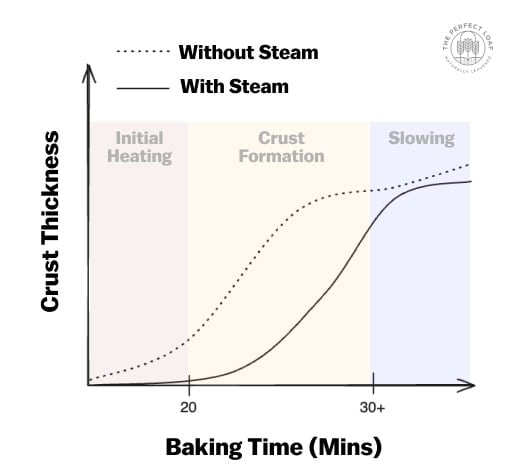
In the diagram above, you can see three distinct phases of a bake:
- Initial phase: During the first baking stage as the dough begins to heat, crust hardening is delayed if the oven has steam (usually 20 minutes). If the oven does not have steam, crust hardening begins.
- Crust formation phase: After the oven is vented of steam, crust hardening begins rapidly. In a dry oven, the crust continues to harden and thicken.
- Slowing phase: Near the end of baking, the crust begins to insulate deeper areas of the dough, thereby slowing crust formation. When the bread is finished baking, the dough baked with steam will have a thinner crust (assuming all else is equal).
Since steam helps keep the crust moist, delaying its hardening and setting, you’ll often see that bread baked in a wood-fired oven has a duller, thicker, and harder crust.
Now that we’ve determined that steam is good when baking bread, let’s combine all the elements to create a loaf with a thin crust.
How to Get Thin Crust On Sourdough Bread
The following are my go-to techniques for ensuring my bread has a thin crust.
1. More Steam at the Beginning of Baking
Often, when your bread has an overly thick crust, the first thing to consider is if there was a lack of steam in the oven during the initial baking. We’ve learned that the longer the dough is baked vented (in a dry oven), the thicker the crust.
When Baking Open (On a Surface)
Adding a little more steam when baking dough uncovered directly on a baking surface (like a baking steel or baking stone) is an excellent way to ensure your bread has a thinner crust.

If you follow my technique for steaming a home oven and find the crust is still thick, add another cup of ice to the hot roasting pan 5 minutes into the bake. This additional blast of steam will ensure plenty of moisture saturation on the dough’s exterior surface, keeping it thin and soft for longer.
Additionally, you can wait to vent the oven of this steam until 30 or 35 minutes into the bake instead of the typical 20 minutes, as discussed below.
When Baking Covered (with a Dutch Oven or Baking Shell)

If your dough is covered, as it would be in a Dutch oven or using a Baking Shell, the typical duration for covering is the first 20 minutes of baking. Instead, lengthen this time to 30 or even 35 minutes. This will steam the dough for longer.

Additionally, a little trick I like to use, especially with a Dutch oven, is to place a single ice cube into the Dutch oven before quickly covering the dough. This additional burst of steam is rather dramatic since all of it will be trapped inside the pot during baking.
2. Bake For Less Time (At a Higher Temp)
The longer bread is baked in the oven, the more time it has to dry on the exterior, thus the thicker the crust. Though it may seem somewhat counterintuitive, you’ll get a thinner crust if you bake slightly hotter and for a shorter time (if you strictly bake at a hotter temp, you’ll actually get a thicker crust).
For instance, if you regularly bake at 450°F (230°C) for 50 minutes (which I recommend in my Beginner’s Sourdough bread), but your crust is thick and hard, try baking at 475°F for 30 minutes*.
(*Note that the actual time may be 25, 30, 40—it all depends on your oven. The first time you bake with an increased temp for reduced time, keep an eye on the dough to judge how the loaf bakes in your oven.)
The catch here is that you must ensure the interior temperature reaches around 204°F (95°C) (or the temperature listed in any recipe) by the time the exterior is fully colored. So, you’ll have to find a balance between baking hot and short while still baking the dough thoroughly.
A great example of a long bake time yielding a thicker crust would be a sourdough miche. Due to the size of these loaves (the one below was 2 kilograms) they require over an hour to bake. This longer bake time results in a thicker, crustier crust (which is expected and desired for this style of bread).
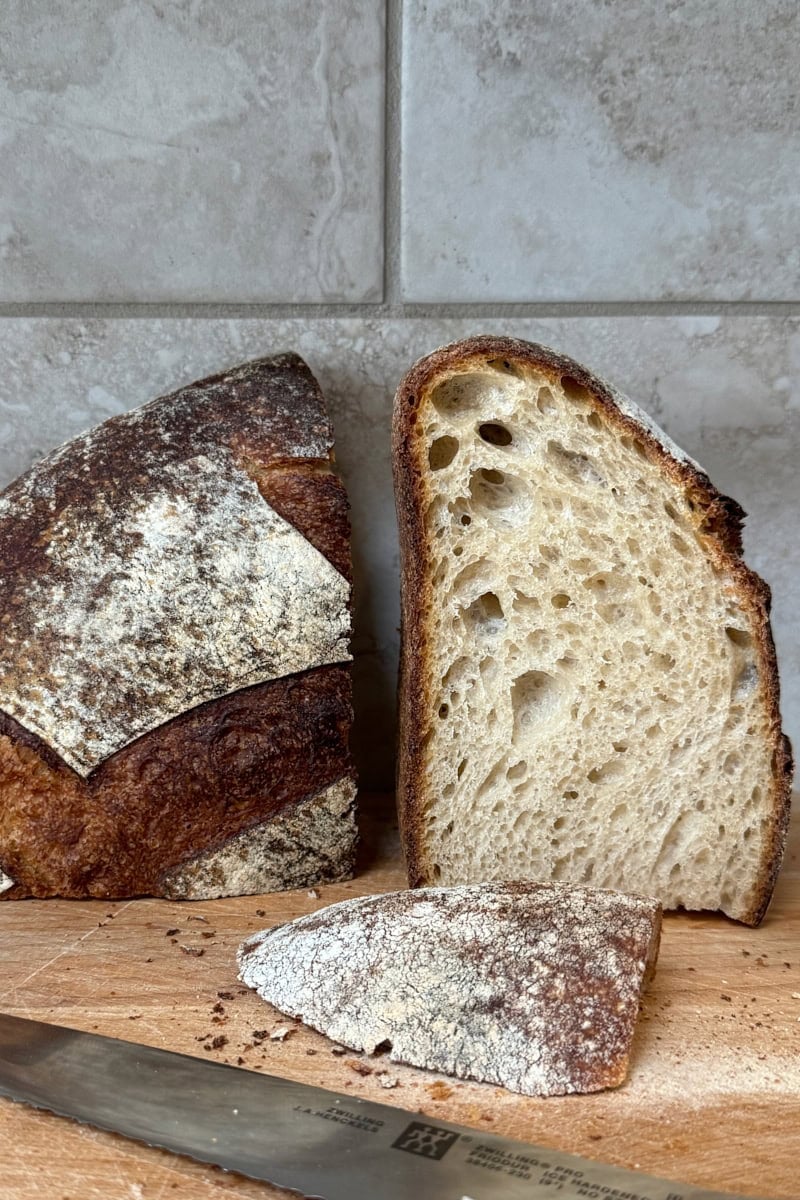
3. Ensure Dough is Fully Proofed
Underproofed dough will bake into a gummy loaf with a super-thick, hard crust. Part of what makes a crust thin is the dough’s fermentation level. Properly fermented dough contains lots of little bubbles throughout, and these little bubbles (and the open “space” contained in them) lighten the dough. As the crust sets, these bubbles are fixed (see the layers in the image below). A dough with few bubbles—underproofed dough—will be denser and less airy than a sufficiently proofed dough.
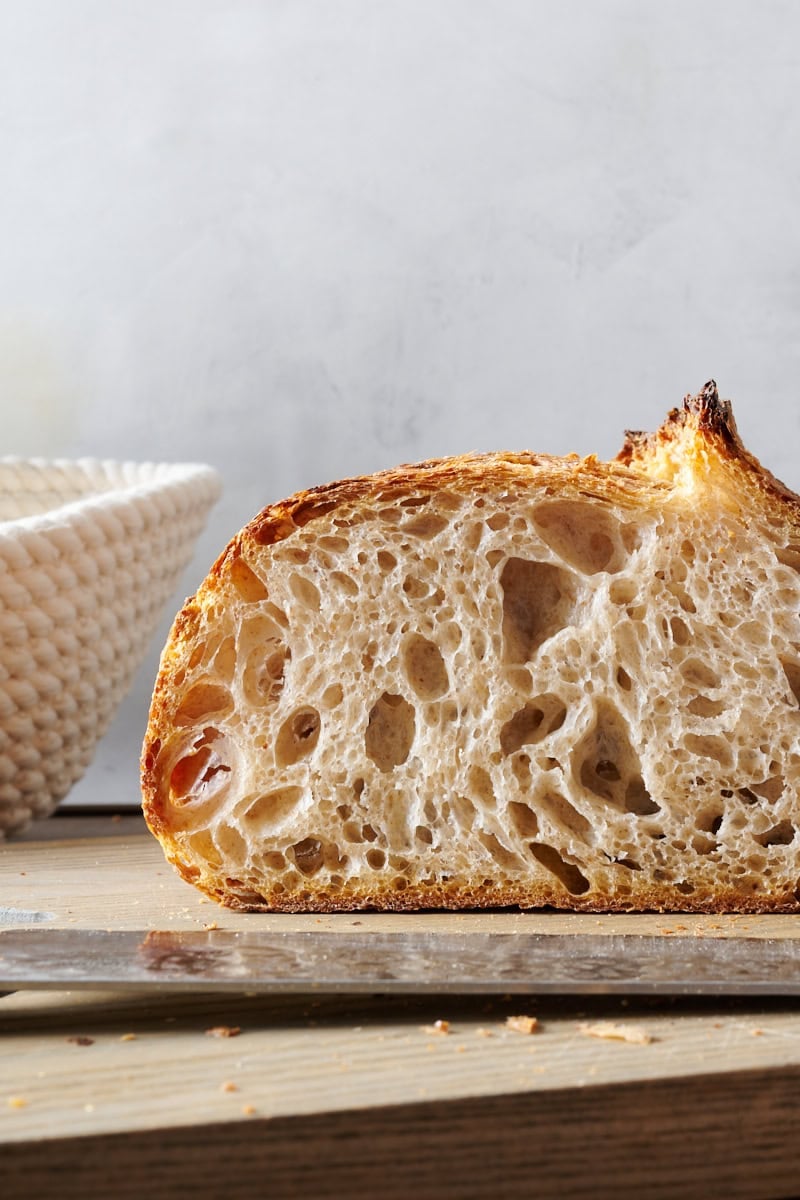
This is similar to how pie crust bakes. The butter that takes up space in the dough melts, and the water in the butter evaporates in the oven, leaving behind space that makes the dough flakey.
A dough with few bubbles—underproofed dough—will be denser and less airy than a sufficiently proofed dough.
4. Bake Dough Without Cold Proofing (Retardation)
Dough proofed in shape in a refrigerator or retarder will have a thicker crust than bread baked the same day it’s mixed (direct dough). This is because the outer surface of the dough will dry when it’s in the fridge during the long proof. As we previously learned, excessive drying on the exterior of the dough will result in a thicker crust during baking.
There are good reasons to cold-proof your dough–increased flavor, scheduling, and easier scoring, for example–but this is something to keep in mind if you’re shooting for the thinnest crust on your sourdough bread.
This is one reason why, when making sourdough baguettes, I cold bulk ferment the dough (en bac) in the refrigerator after a few hours of warm bulk fermentation instead of cold proofing the dough after shaping.

Does Baking in a Dutch Oven Give Bread a Thick Crust?
Yes, I’ve generally found that baking in a Dutch oven often gives bread a thicker crust. This is primarily due to the heat retention of cast iron, which exposes the dough to very high temperatures for prolonged periods.
To avoid this, after the dough has set (usually after about 30 minutes into baking, with 10 of those uncovered), gently and carefully tip the loaf out of the Dutch oven to finish baking on the oven rack.
See my guide on Dutch oven baking for more techniques for avoiding a thick crust.
How Does Crust Thickness Prevent It From Going Stale?
On my recent The Perfect Loaf trip to Altamura, Italy, we saw (and tasted!) firsthand the famous bread made in the area. One of its hallmarks is its keeping quality: they claim it keeps for weeks. The bakers there talked about the thick bread crust and how this, along with sourdough fermentation, helped the bread stay fresh for an exceptionally long time.
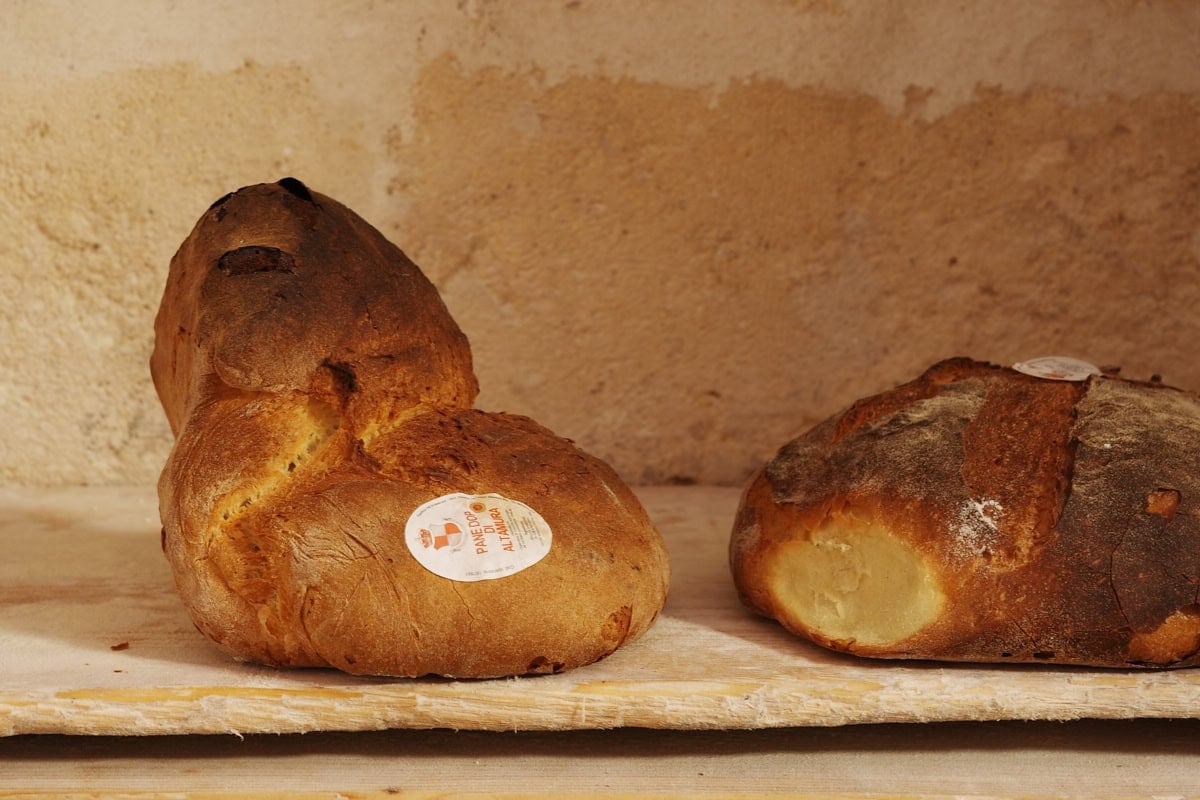
So, there’s a tradeoff here between crust thickness and preservation. A thin-crusted sourdough bread will still keep well, but less so than a loaf with a thicker crust.
Ingredients For a Thin and Soft Bread Crust
One final piece of this puzzle is doughs containing enrichments like oil, butter (or any dairy), sugar, and eggs. These additions contribute to crust (and crumb) softness because they interfere with gluten development, which prevents an overly tough dough, and they retain moisture, which keeps the dough soft.
We can see the effect of these enrichments firsthand when working with dough like sourdough cinnamon rolls, which have eggs, sugar, and butter added for softness—and boy, are they soft.
However, these enrichments have less effect on the crust thickness than the other factors discussed above: heat penetration, moisture migration (drying), and time exposed to heat in the oven.
Thin Crust Bread With the Pullman Pan
Using a Pullman pan—a pan with a slide-on lid—ensures the dough baked inside will have a thin crust on all sides of the loaf. The lid traps steam inside and insulates the dough from being exposed directly to the oven’s heat, thereby reducing drying. As we’ve just learned, less drying on the exterior of the baking dough results in a thinner crust.
You can see the effects of using a Pullman pan in my sourdough Pain de Mie.

Thin Crust Bread FAQs
Does high protein flour make bread crust thick?
Using high-protein white flour in a bread dough won’t necessarily make for a thick-crusted loaf of bread. However, I find that it can make the crust a touch harder and, depending on how much of this flour is used, slightly rubbery in texture—especially if the dough isn’t sufficiently hydrated.
Can I bake thin-crusted bread in a gas oven?
Since gas ovens have more vents and ports that leak steam than an electric oven, it’s more challenging to bake thin-crusted loaves in them if you are baking dough uncovered on a surface. When baking bread in a gas oven, I recommend using a Dutch oven or a Baking Shell so that you can trap steam. However, using a Dutch oven usually results in bread with a slightly thicker crust due to the heat retention properties of cast iron.
Does sourdough bread always have a thick crust?
No, not necessarily. If sourdough bread is baked for a shorter period with plenty of steam, it can have a very thin, brittle crust.
What’s Next?
Any sourdough bread can be adjusted to have a thinner or thicker crust. By focusing on baking for a shorter time (potentially a hotter temperature), introducing more steam during baking, and a few other options, we can shift toward a thinner crust that’s easier to cut.
Using these techniques, try your hand at my Weekday Sourdough Bread for a thin-crusted and easy loaf!
Or, for more on baking, from steaming to pans to scoring, see my Ultimate Guide to Baking Sourdough Bread.


